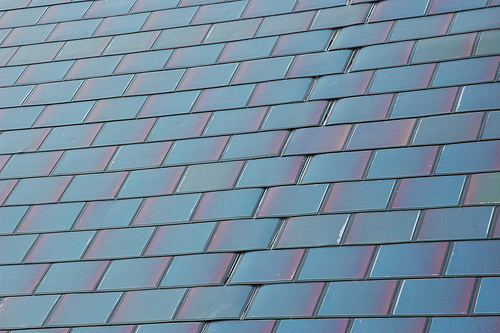Solar shingles are originally a development from the Dow Company (originally Dow Chemical Company) in 2005 although since then other companies have come out with versions of the same idea. But any way you consider solar shingles, they’re a great idea and one which has truly redefined the concept of ‘the roof’. “Solar shingles” is the name most commonly used for these devices but they are also referred to as ‘thin film cells’ or ‘building integrated photovoltaics’ (BIPV’s). They are not to be confused with “solar panels”. Solar panels are an earlier development even though they also can be and still are used ‘on the roof’. In fact, in some instances solar panels might be preferable to solar shingles. It depends on several factors one of which is the angle of the roof to the sun. Solar panels can be angled whereas solar shingles obviously cannot.
Solar shingles are also unique in that they are a much thinner product. Matter of fact they are often referred to as ‘thin-film cells’. The actual substance in them is copper indium gallium diselenide. They are not as efficient in converting sunlight to electricity as the traditional, thicker technology but they are significantly less expensive to make.
In a recent interview with Tony, the owner of a Toronto Roofing Repair Company he revealed that: “Bottom line, they are a wise choice in many situations and one which an increasing number of people are choosing. Solar shingles look very similar to regular roofing shingles so if you want to ‘go solar’ without looking like it, solar shingles are the answer”. While they come highly regarded by most industry professionals there are entry barriers for new dealers. Dealers must be properly trained the install them. They were first used in the Colorado market but Dow currently has authorized dealers in also in Connecticut, Louisiana, Maryland, Massachusetts, Michigan, New York, North Carolina, and Texas.
In appearance they are very similar to regular roofing shingles. Usually they measure 12 by 86 inches but when applied have a slightly smaller exposed surface. They are applied by staples directly to the roofing cloth just like regular shingles although some types have slightly varying mounting requirements. They can also be intermixed with regular asphalt shingles.
This relatively new technology isn’t as expensive as you might think. When federal tax credits of 30% and also the typical savings on electricity bills are factored against the usual cost of installing solar shingles, the ‘payback’ point occurs around halfway during the life of the product.
In considering whether solar shingles make sense for you, one thing to consider is how much life you have left in your current roof. If it’s more than 5 years you’re probably OK to go ahead and install solar shingles. If it’s less…. maybe not. The best thing to do here is have a professional give you some advice because they know how to calculate all the relevant factors.
Still, solar is America’s fastest growing source of alternate energy and it’s one of the reasons that America is lessening its dependence on foreign oil Green technology still makes sense for the environment and it is having a small but growing effect on the employment picture because the vast majority of it is US based. Every kilowatt generated by solar is a kilowatt less generated by burning something or by nuclear fuel.
About the author: Stan D. Jr. is a geen living devotee and a project manager at his family business “Granite Countertops Toronto“. Stan has been comitted to his environmentally friendly lifestyle for over a decade helping plan and execute green projects for his clients and family.
